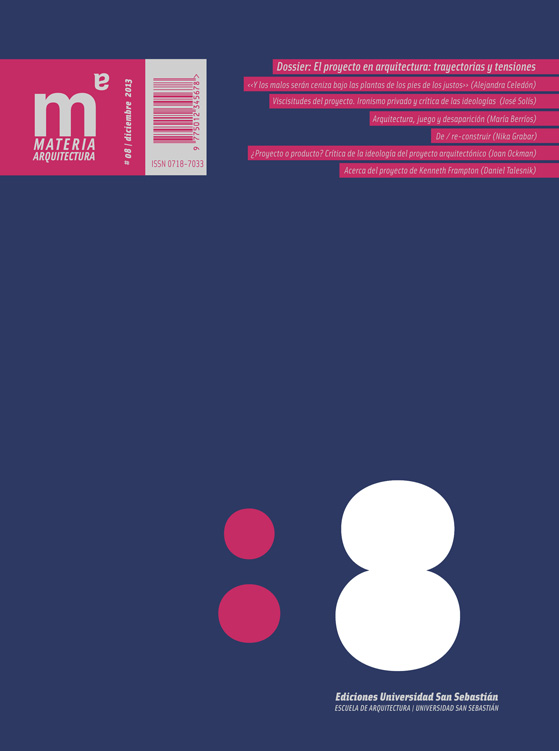Project or Product? A Critique of the Ideology of the Architectural Project
Article Sidebar
Keywords:
Main Article Content
Abstract
They always look forward; they are an anticipation of victory over the forces of entropy in the world. But as such they demand the
jettisoning of ballast and the rejection of whatever impedes their flow. To be “postcritical“ – a term that was in vogue among architects just a few years ago – is to be without friction. In this sense the ideology of the architectural project is one of forgetting. To remind ourselves that architecture is produced, that architects are producers as well as authors, that buildings are not just finished forms but moments in a cycle of production, and that architecture strives to be beautiful in a world that is often and tragically ugly is to give the things we make a history and a conscience and to insist on the solidarity of our work with society at large.
Article Details
Materia Arquitectura provides immediate and free access to all the content of this online edition, published simultaneously with the print edition.
Materia Arquitectura does not charge authors for any concept.
All contents of this electronic edition are distributed under the Creative Commons license of "Attribución-shareAlike 4.0 Internacional" (CC-BY-SA).
The rights of the published texts and images belong to their authors, who grant Materia Arquitectura the license for their use. The management of the permits and the authorization of the publication of the images (or of any material) that contains copyright and its consequent rights of reproduction in this publication is the sole responsibility of the authors of the articles.
As long as they mention their origin, the authors are free to distribute their articles by other means. Any total or partial reproduction of the material must mention its origin.
Downloads
References
BARROW, L. R. (2000). Appendix 4. Case Study 2: Frank O.Gehry and Associates. En L. R. Barrow, Cybernetic Architecture - Process and Form - The Impact of Information Technology. Cambridge, MA: Harvard University (disertación PhD).
BENJAMIN, W. (1979). Reflections: Essays, Aphorisms, Autobiographical Writings. (E. Jephcott, Trad.) Nueva York: Harcourt Brace Jovanovich.
BOLTANSKI, L. & CHIAPELLO, E. (2005). The New Spirit of Capitalism. (G. Eliiott, Trad.) Londres: Verso.
DE BROSSES, C. (1760). Du culte des dieux fétiches, ou Parallèle de l’ancienne Religion de l’Egypte avec la Religion actuelle de Nigritie. París.
ENGELS, F. (1999). The Condition of the Working Class in England. Oxford: Oxford University Press.
GIEDION, S. (1954). Space, Time and Architecture (3a ed.). Cambridge, MA: Harvard University Press.
GIUFFRIDA, A. (9 de febrero de 2011). U.A.E. Construction Workers Stranded, with No Pay and No Prospects. New York Times. Recuperado de www.nytimes.com/2011/02/10/world/middleeast/10iht-M10WORKERS. html?pagewanted=all
JACOBS, A. (19 de Septiembre de 2011). China Shuts Solar Panel Factory after Antipollution Protests. New York Times. Recuperado de www.nytimes.com
MARX, K. (1976). The Fetishism of Commodities and Its Secret. En K. Marx, Capital (B. Fowkes, Trad., Vol. 1). Hammondsworth: Penguin Books.
MARX, K. (1981). The Trinity Formula. En K. Marx, Capital (D. Fernbach, Trad., Vol. 3). Hammondsworth: Penguin Books.
MUSCHAMP, H. (7 de septiembre de 1997). The Miracle in Bilbao. New York Times Magazine, pág. 72.
SMITH, J. H. & MANTZ, J. W. (2006). Do Cellular Phones Dream of Civil War? The Mystification of Production and the Consequences of Technology Fetishism in the Eastern Congo. En M. Kirsch (Ed.), Inclusion and Exclusion in the Global Arena. Londres: Routledge.
SOMOL, R. E., & WHITING, S. (2005). Okay, Here's the Plan. Log(5), 5-7.
Most read articles by the same author(s)
- Joan Ockman, ¿Proyecto o producto? Crítica de la ideología del proyecto arquitectónico , Materia Arquitectura: No. 08 (2013): Materia Arquitectura 08 (Diciembre/December 2013)
